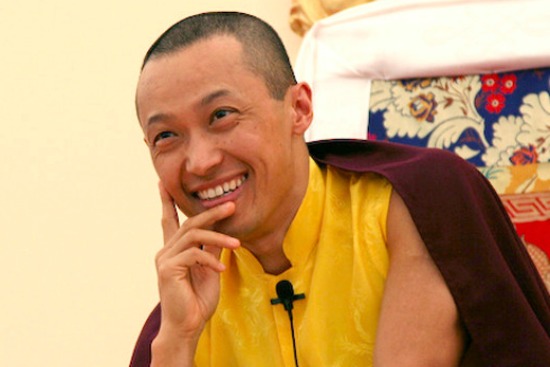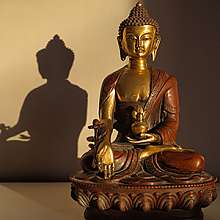Obstacles Arise by Sakyong Mipham Rinpoche
*This article originally appeared the Shambhala Times Community News Magazine on February 13, 2015
In meditation, we are on a journey from here to there — to whatever we are trying to accomplish, be it mindfulness, peace, or compassion. We are developing the ability to have fuller experience of our lives. But as we gain understanding and insight, there is a build-up of residue. We call these dons, or obstacles. An obstacle is something that cuts the line of our intention. Sitting in meditation with the motivation of benefitting others, if we realize we are thinking about work, then obviously our intention has been cut. We are no longer on that particular journey.
The tricky thing is that we don’t always know obstacles are happening. To detect them, we have to know our mind and our intention. The point is to be vigilant as we practice. It is true that as we settle our mind through meditation, any kind of imperfection in our character becomes stronger. With awareness, we can manifest our own genuineness about any obstacle we face. Intention is important.
The first obstacle is fame. If you have a little ambition for fame, it will become stronger, and you will find yourself not actually practicing for your own peace or for the welfare of others, but to be known as a wise and spiritual person who meditates a lot.
The next don is pride or arrogance. There are two kinds of pride. The first is confidence in one’s buddha nature. With this kind of confidence, there is naturally a sense of vibrancy. With the second kind of pride — ordinary pride, the don of pride — as much as you practice, your mind remains ordinary and does not really change. In addition, as you practice, questions and doubts about others’ realization arise: whether it is another practitioner or the teacher, you doubt that they have it. Your pride begins to reverse itself as your mind fills up with this discursiveness about others’ realization because, in fact, no realization is occurring for you. Arrogantly demoting others becomes the only way to protect your ordinariness.
The next don is good old laziness. Obviously there are many categories of laziness. The outer ones — common laziness, disheartenment, and busyness — can keep us from ever even reaching the cushion. There is also laziness in the sense of mentally putting off your practice or not really being engaged in it, even while still expecting results. It is being there but not really being there, and still wanting something. If we’re feeling lazy, even if we somehow make it to our seat, we’ll spend the session avoiding the basic technique. We don’t even have the energy to sit up straight. We can’t practice properly.
Then there is the don of ambition. If ambition begins to take over, your mind starts going toward external gain and loss. Instead of doing the meditation technique, you focus on work, your relationship, or your next vacation. Ambition is a sign that we are trying to appease our suffering by thinking that something external will make us happy. That approach is ego-centered and aggressive. It will never appease the suffering; it will always just fire it up.
Then there is the don of delusional meditation. “Fool’s meditation” is based not on the teacher’s instructions on meditation or the appropriate subjects for contemplation, but on your own personal concoction, your own little meditative brainchild. You can’t possibly know what you are doing because you are just now trying it for the first time.
Another don is envy, and we could include complaint. With this don, you are not really focused on your own development. You stop working on your own faults and become envious of other people. In particular, you begin to blame others for your faults. The problem with blame and complaint is that it always leads to more blame and complaint. It’s endless; it fosters a continual sense of dissatisfaction. When our mind goes in that kind of loop, we can’t see our own projection.
We could consider dons as purely psychological, but at the same time, these obstacles do begin to manifest, and they are not isolated scenarios. One don arrives, bringing others along; they know how to set up a household. Even when the obstacle is very strong, it is important to keep meditating. Fear can paralyze us. We may sit there and imagine that the obstacle will just disappear, without realizing that we actually have to engage. We have to come out of that fear and start doing something.
If you are going up the mountain and there is a rock, you have to move it, go around it, or climb over it. If you are already on top of the mountain, the rock is behind you; it doesn’t matter. However, if you are meditating and pretending you are on top of the mountain, when in fact you are on the path, the rock is still going to block your path. You have to relate to it.
Meditation is very much an invisible walk — body is sitting, mind is moving, and you are walking with what you intend to do. Gentleness toward yourself is very important. Gentleness means nonaggression, which is the best way to keep going. The dons are going to happen, and we have to know how to work with them. Once I was talking with Dilgo Khyentse Rinpoche about my meditation. He said, “Rinpoche, relax.” Essentially, he was saying, “You are going to be doing this your whole life. There will be another session!”
When you are developing virtue or goodness on a relative scale, it is clear that you have to know what nonvirtue is. Seeing our dons provides that opportunity. The first antidote for dons is recognition. It is important to know that they are natural. We have to pay attention: “What am I doing? What am I thinking about?” We should not be shocked or embarrassed if we find pride or ambition arising. Instead, we can gently think, “Hmm. It’s interesting how that happened.” That is bravery: recognizing what it is happening and dealing with it.
The second antidote is to come back to your intention, often felt as a sad and longing heart that leads us to realize, “This moment is precious. Life is short. Everything is unstable. My good fortune is amazing.”
The third instruction is very simple — follow your teacher’s instructions. Meditation is a long journey. You cannot be both teacher and student. Thinking “I am the teacher and the student” is the delusional don. You are making up your own recipe. If the teacher’s instruction to refocus your mind on the breath or another object of meditation is too weak an antidote, or if you find it effective for only so long before your mind wanders off again, then focus on your intention in doing the meditation.
Running marathons is a good metaphor for the different levels of feeling our meditation will have. When you run a marathon, you reach a point when it is very hard, but you stay with the form and breathe. You don’t think much about whether you are going to make it or not. Then your body relaxes and you find a different level of exertion. To finish is a minor miracle — and what allowed it to happen is just staying with it.
 About Sakyong Miphan Rinpoche: The Sakyong, literally translated as “earth protector,” is a dharma king and lineage holder of the Shambhala lineage, guiding thousands of students around the world in the path of meditation. Born in Bodhgaya, India, in 1962, the Sakyong is the eldest son of Chögyam Trungpa Rinpoche and Lady Könchok Palden. Learn more about him here.
About Sakyong Miphan Rinpoche: The Sakyong, literally translated as “earth protector,” is a dharma king and lineage holder of the Shambhala lineage, guiding thousands of students around the world in the path of meditation. Born in Bodhgaya, India, in 1962, the Sakyong is the eldest son of Chögyam Trungpa Rinpoche and Lady Könchok Palden. Learn more about him here.








